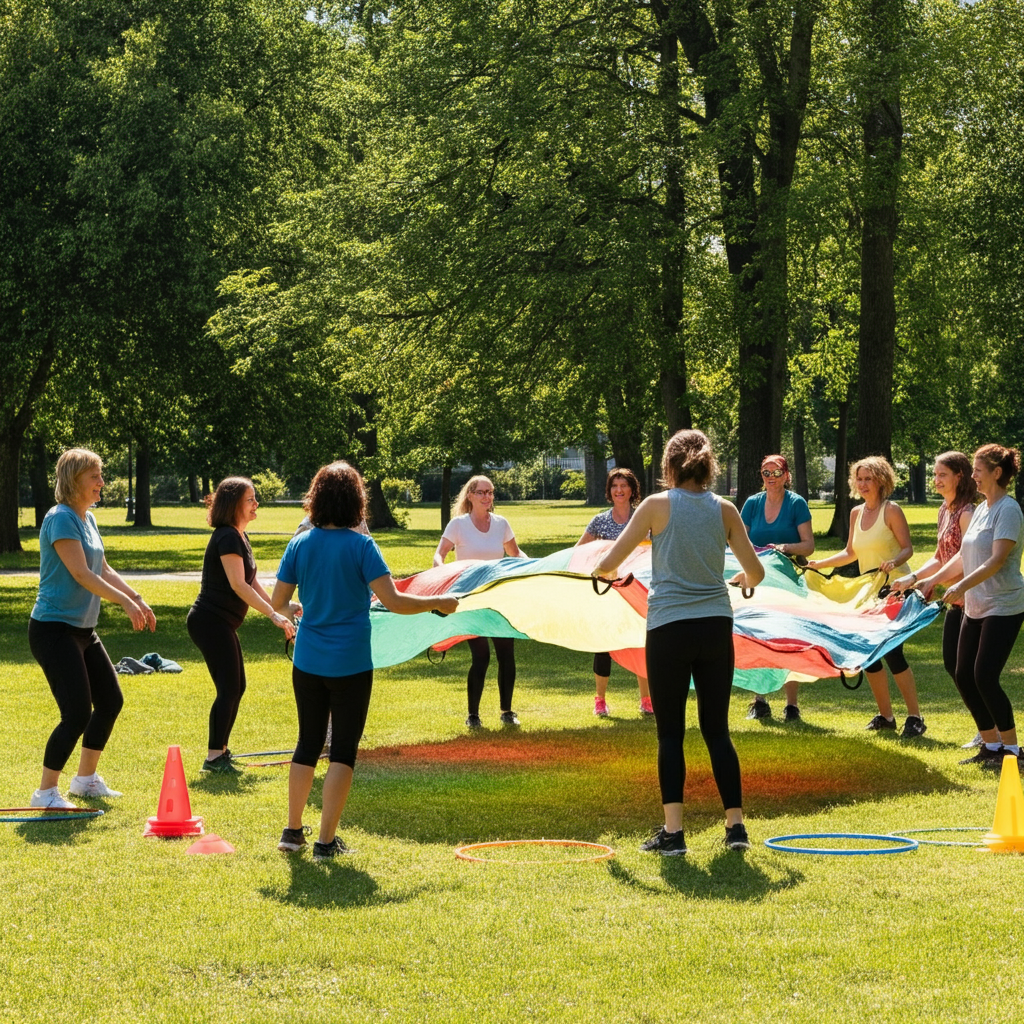
Introduction
Movement games revolutionize how we think about physical activity, combining fun with fitness in ways that captivate players of all ages. These interactive experiences turn everyday areas into vibrant playgrounds where education and movement collide, offering significant chances for social, cognitive, and physical growth.
Structured play promotes physical activity while addressing important health issues and developing vital life skills. For parents, teachers, and anybody else looking to encourage active lifestyles, movement games provide an alternative that feels less like exercise and more like pure enjoyment.
This thorough guide will teach you how to use movement games efficiently, comprehend their many advantages, look at particular activities for different needs, and modify these games for different age groups and skill levels. Movement games offer flexible solutions for stimulating active play, whether you’re dealing with rambunctious toddlers or controlling classroom dynamics.
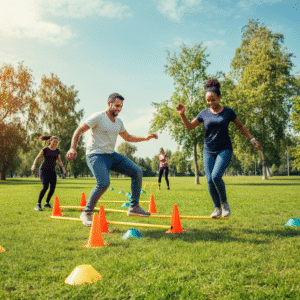
How to Play Movement Games
In order to keep players actively involved, movement games combine motion, goals, and rules to create structured physical activities. Because they include precise rules, well-defined objectives, and structured patterns that direct player behavior while preserving the unplanned joy of movement, these games are different from free play.
Setting Up Your Movement Game Space
When designing a space for movement games, safety and accessibility must be carefully considered. Start by removing any furniture, obstructions, and possible dangers from a specified area. All participants should be able to move freely in all directions and be comfortably accommodated in the space.
Soft flooring, such as exercise mats or carpets, is advantageous for indoor areas because it offers cushioning for sitting, rolling, and jumping exercises. Make sure the ceiling height is sufficient for games that call for jumping or arm motions. To assist players in understanding the limits of the play area, clearly mark boundaries with tape, cones, or organic barriers.
Although they provide greater flexibility, outdoor areas need different safety precautions. Look for any potentially dangerous debris, holes, or uneven surfaces. Take the weather into account and prepare backup indoor options. Play areas can be successfully defined by natural boundaries like trees or playground equipment.
Essential Equipment and Materials
Most effective movement games require minimal equipment, making them accessible and affordable for any setting. Basic supplies include:
Visual Aids: Flashcards, picture cards, or simple drawings help communicate game concepts, especially for younger children or non-verbal participants. Create sets of themed cards representing animals, actions, colors, or objects relevant to your specific games.
Marking Tools: Colored tape, chalk, cones, or hula hoops help define spaces, create boundaries, and establish stations. These tools make abstract concepts tangible and provide visual reference points during gameplay.
Simple Props: Lightweight balls, scarves, ribbons, or handmade items like paper snakes add tactile elements to games. Choose soft, safe materials that won’t cause injury if thrown or dropped.
Audio Equipment: A simple music player or smartphone enables rhythm-based games and helps control game pace through musical cues.
Basic Game Structure and Rules
Successful movement games follow predictable patterns that help participants understand expectations and feel secure within the activity structure. Begin each session with a brief explanation of rules, demonstrate expected movements, and practice transitions between game phases.
Opening Routine: Begin with easy warm-up exercises that progressively boost vitality. This could involve simple coordination exercises, walking in circles, or mild stretching. Regular opening exercises assist players in preparing their minds for more active gameplay.
Core Activity Phase: Explain the basic rules of the main game. When working with younger participants, use demonstrations rather than long explanations. Divide difficult games into manageable chunks and become proficient in each one before putting them together.
Cool-Down Transition: Finish strenuous games with relaxing exercises that assist players in controlling their energy levels. This keeps group dynamics harmonious and avoids sudden changes.
Safety Protocols: Provide unambiguous cues for beginning, ending, and pausing games. Participants should learn how to spot when someone needs assistance or needs a break. Establish inclusive policies that do not discriminate against varying degrees of participation.
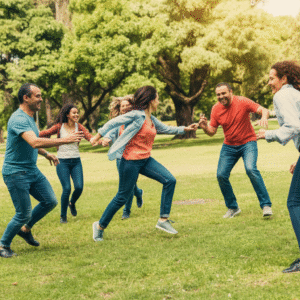
Adapting Games for Different Abilities
Movement games excel when adapted to accommodate diverse abilities and needs. Successful adaptation maintains the core fun elements while modifying physical demands, cognitive complexity, or sensory requirements.
Physical Modifications: For games that typically require standing, allow seated participation, reduce jumping to stepping, or replace running with rapid walking. Give players several options for completing the same game objective so they can select the one they like best.
Cognitive Adjustments: Simplify rules for younger children or those with learning differences. Use visual supports, repeat instructions frequently, and pair new participants with experienced players for peer support.
Sensory Considerations: It’s possible that some participants are sensitive to sudden movements, crowded areas, or loud music. Provide quiet options, stick to a schedule, and establish peaceful areas where overstimulated participants can withdraw without completely abandoning the activity.
Inclusive Participation: Create games where participation, not competition, determines success. Honor hard work and ingenuity over accuracy or speed. Regardless of their physical capabilities, this method guarantees that every participant has positive results.
Benefits of Movement Games for Kids
Movement games help children grow in many areas at once and offer extensive developmental advantages that go well beyond physical fitness. Through play, these activities foster the natural development of social skills, cognitive abilities, and motor skills in rich learning environments.
Physical Development and Motor Skills
Children who play movement games on a regular basis develop their gross and fine motor skills as well as their general physical fitness. In ways that traditional exercise frequently cannot, these activities test various muscle groups, improve coordination, and cultivate body awareness.
Gross Motor Development: Running, jumping, balancing, and throwing all require large muscle movements that improve limb coordination and core stability. Children can learn to control their bodies in three dimensions and develop spatial awareness by playing games that require whole-body movements.
Fine Motor Skills: Many movement games incorporate precise hand movements, finger coordination, and eye-hand coordination tasks. Activities like catching small objects, manipulating game pieces, or performing specific gestures strengthen the small muscles necessary for writing, drawing, and daily living tasks.
Balance and Coordination: Movement games challenge children’s vestibular systems through activities requiring balance, directional changes, and coordination between different body parts. These experiences build foundational skills necessary for more complex athletic activities and everyday movements.
Cardiovascular Health: Playing active games naturally raises breathing and heart rate, offering cardiovascular exercise in a fun way. Youngsters gain stamina and endurance without the perceived effort that comes with more conventional fitness activities.
Cognitive and Academic Benefits
Movement games stimulate brain development and enhance academic performance through multiple pathways. Physical activity increases blood flow to the brain, promotes neural growth, and creates optimal conditions for learning and memory formation.
Executive Function Development: Games requiring rule-following, turn-taking, and strategy development strengthen executive function skills including working memory, cognitive flexibility, and inhibitory control. These skills directly transfer to academic success and life management abilities.
Language Development: Many movement games incorporate verbal instructions, vocabulary building, and communication skills. Children learn new words in context, practice following complex directions, and develop listening skills through game participation.
Mathematical Concepts: In movement games, counting, pattern recognition, spatial relationships, and sequencing all come naturally. Youngsters investigate mathematical ideas through hands-on activities, giving abstract concepts a tangible and enduring form.
Problem-Solving Skills: Games requiring strategy, adaptation, or creative solutions develop critical thinking abilities. Children learn to analyze situations, consider multiple options, and implement solutions in real-time scenarios.
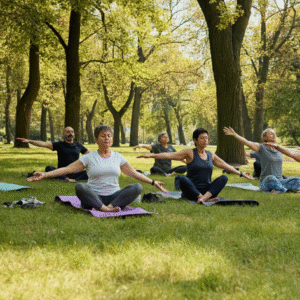
Social and Emotional Development
Movement games create powerful opportunities for social learning and emotional growth in supportive, structured environments. These activities teach cooperation, communication, and conflict resolution skills while building confidence and self-esteem.
Teamwork and Cooperation: Many movement games require collaboration to achieve shared goals. Children learn to work together, share resources, communicate effectively, and support teammates through challenges.
Emotional Regulation: Children who engage in physical activity are better able to process their emotions and learn self-control. Children learn how to control their excitement, disappointment, and frustration in social situations while playing movement games, which offer healthy ways to express energy and emotions.
Social Skills: Turn-taking, sharing, observing social norms, and having constructive interactions with peers are all necessary for game participation. Youngsters develop their social skills in low-stakes settings where errors are viewed as teaching moments rather than as social failures.
Confidence Building: Success in movement games builds self-efficacy and confidence. Children discover their capabilities, overcome challenges, and experience the satisfaction of skill development in supportive environments.
Long-term Health and Wellness Impact
Positive early movement game experiences lay the groundwork for lifetime physical activity and health consciousness. Youngsters who engage in active play during their formative years are more likely to lead active lives as adults.
Positive Activity Associations: Movement games help children associate physical activity with fun, friendship, and success rather than competition or pressure. These positive associations encourage continued participation in physical activities throughout life.
Body Awareness and Health Consciousness: Through movement games, children develop awareness of their bodies’ capabilities and needs. They learn to recognize the connection between activity and feeling good, establishing healthy lifestyle patterns early.
Stress Management Skills: Regular physical activity through movement games provides children with healthy coping mechanisms for stress and anxiety. These skills become valuable tools for managing academic pressure and life challenges.
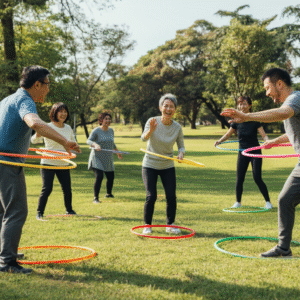
Movement Games for ADHD
Activities that involve movement help children with Attention Deficit Hyperactivity Disorder (ADHD) focus and regulate their energy in a constructive way. In addition to giving hyperactive people structured outlets, movement games help kids develop lifelong skills.
Understanding ADHD and Movement Needs
About 6.1 million kids in the US suffer from ADHD, which manifests as impulsivity, hyperactivity, and inattention. Physical activity improves executive function, increases neurotransmitter production, and offers opportunities for sensory regulation, all of which have been shown to help manage ADHD symptoms.
Neurological Benefits: Physical activity stimulates dopamine, norepinephrine, and serotonin production—neurotransmitters often imbalanced in individuals with ADHD. Movement games provide natural, medication-free support for neurochemical balance.
Attention and Focus: Despite popular belief, children with ADHD frequently exhibit exceptional focus when participating in stimulating physical activities. When compared to sedentary tasks, engaging movement games can greatly increase attention spans.
Sensory Processing: Due to differences in their sensory processing, many kids with ADHD seek out or avoid particular kinds of input. Proprioceptive and vestibular input from movement games can help control sensory systems and enhance general functioning.
High-Energy Movement Games for ADHD
For kids with ADHD, fast-paced games that require a lot of physical activity frequently work incredibly well. In addition to developing skills and fostering positive social interactions, these activities aid in burning excess energy.
Animal Actions Game: Players receive animal cards and must move like that animal across the play space. Include energetic animals like kangaroos (jumping), cheetahs (running), or bears (crawling). This game combines cardiovascular exercise with imagination while providing clear, concrete directions.
Traffic Light Tag: One player acts as the “traffic light,” calling out colors that correspond to different movements—green means run, yellow means walk, red means stop. Add complexity with additional colors representing specific actions like blue for hop or orange for skip.
Obstacle Course Rotations: Make several stations with various physical tasks, such as jumping jacks, balance beam walks, army crawls, or cone weaving. At predetermined intervals, kids move between stations, keeping them active and avoiding boredom.
Dance Freeze with Challenges: Play lively music and promote unstructured dancing. Children should freeze in certain positions or poses when the music stops. Asking students to solve math problems while maintaining the pose will increase the cognitive challenges.
Focus and Regulation Through Movement
Children with ADHD can potentially benefit from the strategic usage of movement games in terms of their attention span and self-control. These exercises are most effective when they incorporate mindfulness or cognitive demands with physical exertion.
Mindful Movement Sequences: Teach basic tai chi or yoga poses that call for awareness of body alignment and breathing. These activities offer soothing input while assisting youngsters in developing self-regulation abilities and body awareness.
Simon Says Variations: Complex, multi-step instructions that test working memory and attention to detail can be added to classic Simon Says games. As children’s talents advance, start with something easy and work your way up to something more sophisticated.
Rhythm and Pattern Games: Timing, sequencing, and attention abilities are developed through activities that involve clapping patterns, drumming sequences, or moving to particular rhythms. These games are effective for both relaxing and high-energy activities.
Balance Challenge Games: Proprioceptive input is provided while focus and attention are challenged by activities that call for prolonged balance or coordination. Activities involving balancing boards, walking on lines, or standing on one foot while working are effective.
Creating Supportive Environments
Children with ADHD benefit from movement game environments that minimize distractions while maximizing engagement and success opportunities. Thoughtful environmental design significantly impacts game effectiveness.
Clear Boundaries and Rules: Establish visible boundaries using tape, cones, or natural markers. Keep rules simple and post visual reminders. Consistent structure helps children with ADHD feel secure and successful.
Minimize Overstimulation: While children with ADHD often need high-energy activities, they can become overstimulated by too many simultaneous inputs. Control noise levels, visual distractions, and group sizes when necessary.
Frequent Success Opportunities: Create games that offer a variety of ways to win and value effort just as much as success. Traditional competitive forms may be difficult for kids with ADHD, but they do well with cooperative or individual challenge frameworks.
Sensory Break Options: When necessary, provide kids the chance to take sensory breaks. These could be quiet areas, tools for fidgeting, or little personal exercises that aid in system resets.
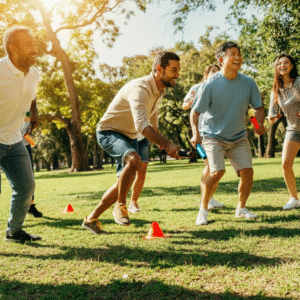
Basic Movement Activities
Basic movement exercises serve as the foundation for increasingly difficult games and physical abilities. These fundamental motions foster the development of motor patterns, coordination, and body awareness that underpin all upcoming physical activities and athletic involvement.
Locomotor Movements
The majority of movement games are based on locomotor movements, which entail moving through space. These fundamental patterns increase cardiovascular fitness, spatial awareness, and coordination while boosting self-assurance when navigating various settings.
Walking and Marching: Often overlooked as too simple, purposeful walking and marching activities build rhythm, posture, and coordination. Vary the pace, add arm movements, or incorporate direction changes to increase complexity. Marching to music helps develop timing and sequencing skills.
Running Variations: Beyond basic running, introduce jogging, galloping, skipping, and leaping to develop different movement patterns. Each variation challenges different muscle groups and coordination patterns while keeping activities interesting and engaging.
Jumping and Hopping: These strong motions test balance and spatial awareness while strengthening and coordinating the legs. Start with two-foot jumps and work your way up to single-foot hops and intricate patterns that incorporate several orientations or sequences.
Crawling and Rolling: Crawling and rolling motions, which are frequently linked to early infant development, offer crucial proprioceptive information and strengthen the core at every developmental stage. Additionally, these motions promote the formation of the cross-lateral brain.
Non-Locomotor Movements
By moving while remaining stationary, non-locomotor exercises help people improve their coordination, flexibility, and body control. These motions frequently make great warm-up exercises or soothing breaks in between intense games.
Stretching and Reaching: Controlled stretching movements help develop flexibility and body awareness. Incorporate reaching in different directions, levels, and speeds to challenge coordination and balance simultaneously.
Twisting and Turning: Rotational movements develop spinal mobility and core strength while challenging proprioceptive systems. These movements can be performed at different speeds and with different body parts leading the motion.
Bending and Swaying: These movements develop flexibility and body control while providing calming, rhythmic input. Combine with breathing exercises or music to enhance relaxation benefits.
Balancing: Static and dynamic balance activities challenge multiple body systems simultaneously while building confidence and body awareness. Progress from simple static positions to complex dynamic balance challenges.
Manipulative Skills
Controlling things by kicking, striking, catching, or throwing is a component of manipulative skills. These abilities foster timing, hand-eye coordination, and spatial awareness while presenting ideas that are applicable to everyday activities and sports.
Throwing and Catching: Start with large, soft objects and progress to smaller, more challenging items. Vary distances, targets, and throwing patterns to develop different aspects of coordination and timing.
Bouncing and Dribbling: Ball skills help toddlers improve their timing and hand-eye coordination while offering repeating, rhythmic input that many find soothing and structuring. Start with big balls and work your way down to smaller, trickier ones.
Kicking and Striking: Kicking exercises with various sized and textured balls help to improve foot-eye coordination. Activities that include striking with paddles, bats, or hands help players improve their timing and coordination.
Rolling and Pushing: Through resistance, these exercises provide proprioceptive input while fostering control and spatial awareness. To generate a variety of experiences, use balls, hoops, or other equipment.
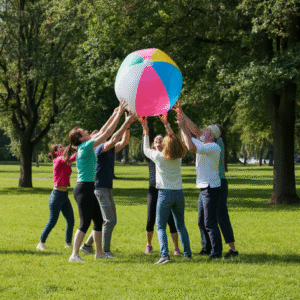
Combining Movement Patterns
The most successful movement exercises blend several movement patterns to provide intricate, difficult situations that mimic the demands of real-world movement. Children are prepared for both complex physical work and participation in sports through these combination exercises.
Movement Sequences: Create predetermined sequences that combine different locomotor, non-locomotor, and manipulative movements. These sequences can tell stories, follow music, or respond to specific cues.
Obstacle Courses: Design courses that require multiple movement types in sequence. Include crawling under barriers, jumping over obstacles, balancing on lines, and throwing at targets to create comprehensive movement experiences.
Partner and Group Activities: Incorporate individual movement abilities into group activities that call for cooperation, timing, and communication.
Environmental Challenges: Utilize environmental elements, whether man-made or natural, to test movement adaption. This could include varied heights, slopes, or uneven terrain that call for adjustments to movement.
Popular Movement Games for Different Age Groups
Movement games that are age-appropriate guarantee participants’ maximum involvement, safety, and developmental benefits. It is easier to choose games that suitably challenge players while preserving enjoyment and success chances when developmental talents and interests are taken into consideration.
Toddlers and Preschoolers (Ages 2-5)
Young children require movement games with simple rules, immediate rewards, and opportunities for repetition. Their developing motor skills benefit from basic movement patterns while their short attention spans require frequent activity changes.
Animal Walk Safari: Children pretend to be different animals, copying the adult leader’s movements. Include bears (crawl on hands and feet), frogs (squat and hop), elephants (bend over and swing arms), and birds (flap arms while walking). This game develops gross motor skills while encouraging imagination.
Musical Statues with Actions: Play music and encourage free dancing or specific movements. When music stops, children freeze like statues. Add challenges by requesting specific statue poses like “tall tree,” “tiny mouse,” or “flying bird.” This develops listening skills and body control.
Color Hunt Movement: Place colored objects or tape around the play area. Call out colors and movement patterns like “hop to something blue” or “crawl to something red.” This combines color recognition with movement practice.
Parachute Play: Using a play parachute or large sheet, children hold edges and perform various movements like making waves, popcorn bouncing, or merry-go-round walking. This develops cooperation skills and provides proprioceptive input.
Simple Simon Says: Use basic movements appropriate for developing motor skills like “Simon says touch your toes,” “Simon says march in place,” or “Simon says balance on one foot.” Keep commands simple and demonstrate each movement.
Elementary Age (Ages 6-12)
School-age children can handle more complex rules, enjoy competitive elements, and benefit from games that combine physical activity with academic skills. Their improved coordination allows for more sophisticated movement patterns.
Capture the Flag Variations: Set up territories with flags or objects to capture. Include safe zones, different movement requirements (hop in certain areas, crawl in others), and team strategy elements. This develops strategic thinking and teamwork.
Movement Math: Create math problems that require physical solutions. “Show me 3 plus 2 by doing that many jumping jacks,” or “Run to the cone that shows the answer to 4 times 3.” This reinforces academic learning through movement.
Obstacle Course Championships: Design complex courses with multiple stations requiring different skills. Include timing elements, point systems, or team competitions. Allow children to help design courses to increase engagement.
Tag Game Variations: Move beyond basic tag to include variations like freeze tag (frozen players become obstacles), flashlight tag (played in dim lighting), or hospital tag (tagged body parts can’t be used until “healed”).
Scavenger Hunt Movement: Create lists of items to find or tasks to complete around the play area. Include movement requirements like “find something red by hopping there” or “locate the hidden treasure by following the map.”
Teenagers (Ages 13-18)
Adolescents benefit from movement games that provide social interaction opportunities, physical challenges, and elements of choice and control. Games should respect their developing independence while providing appropriate physical activity.
Ultimate Games: Adapt ultimate frisbee concepts using various objects like foam balls, flying discs, or bean bags. These games develop teamwork, strategy, and cardiovascular fitness while allowing for different skill levels.
Fitness Challenge Circuits: Create stations with different fitness challenges that participants can modify to their ability levels. Include activities like modified push-ups, jumping variations, balance challenges, and core strengthening exercises.
Dance and Movement Creation: Encourage teens to create their own movement sequences or dance routines, possibly incorporating popular music or cultural dances. This respects their developing identity while providing physical activity.
Sports Skills Clinics: Focus on fundamental skills from various sports presented in game formats rather than formal instruction. This allows exploration of different activities without long-term commitments.
Adventure-Based Games: Include elements of problem-solving, teamwork, and physical challenges that simulate adventure activities like rock climbing, orienteering, or survival skills.
Adults and Mixed Age Groups
Family-friendly movement games create opportunities for intergenerational play while providing physical activity appropriate for various fitness levels and abilities.
Modified Traditional Games: Adapt childhood favorites like red light/green light, hide and seek, or relay races to accommodate different ages and abilities simultaneously.
Cooperative Challenge Games: Focus on group problem-solving that requires physical activity but emphasizes collaboration over competition. Examples include group juggling, human knot games, or trust-building activities.
Cultural Movement Games: Explore traditional games from different cultures that involve movement and can be adapted for mixed groups. These activities provide cultural education while promoting physical activity.
Family Fitness Circuits: Design stations that can be modified for different fitness levels while allowing families to participate together. Include options for different intensity levels at each station.
Nature-Based Movement: Use outdoor environments for movement games that take advantage of natural features while accommodating different ages and abilities through choice and modification options.
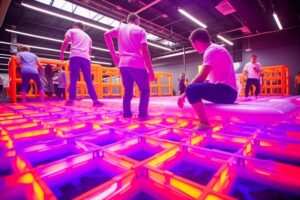
Conclusion
Movement games offer a potent fusion of enjoyment and purpose, fostering social, cognitive, and physical growth in ways that regular exercise cannot. Through movement, these activities turn ordinary settings into dynamic learning environments where adults and children can experience sheer delight while developing vital life skills.
The data makes it very evident that movement games offer far more than just basic physical activity. They improve academic achievement, foster emotional control, develop executive function abilities, and establish favourable correlations with lifetime physical exercise. These games provide especially beneficial support for kids with ADHD and other learning disabilities by providing natural therapeutic interventions and structured outlets for energy.
It takes careful planning, age-appropriate selection, and inclusive design for movement games to be successful and enjoyable for all players. Age-appropriate modifications guarantee maximum engagement and developmental benefits, while the fundamental movement exercises work as building blocks for increasingly intricate games.
As worries over screen time and sedentary lives grow, movement games provide fun, accessible alternatives that need little equipment and can be customised for almost any setting. They give community leaders, educators, and families useful resources for encouraging active lives and fostering closer bonds and communities.
The future of physical activity is not about making people do things they don’t want to do, but about making movement possibilities compelling through imaginative and authentically enjoyable activities. This future is embodied by movement games, which are easily accessible, flexible, and vital for both lifelong wellness and healthy growth.
Begin modestly, maintain consistency, and observe how the straightforward power of active participation in movement games changes not only physical health but entire communities. Today’s investment in movement games lays the groundwork for everyone’s future to be healthier, happier, and more connected.





Leave a Reply